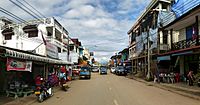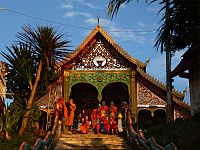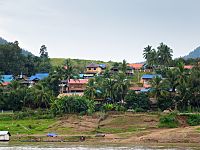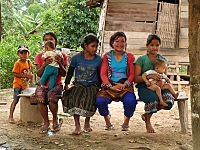Bokeo province facts for kids
Quick facts for kids
Bokeo province
ແຂວງ ບໍ່ແກ້ວ
|
|
|---|---|
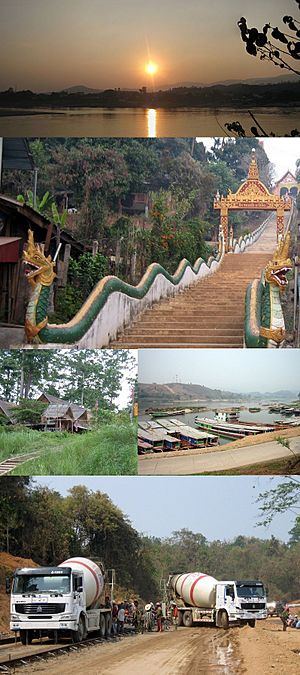 |
|
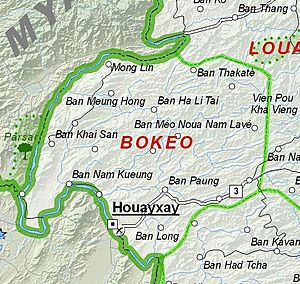
Map of Bokeo province
|
|
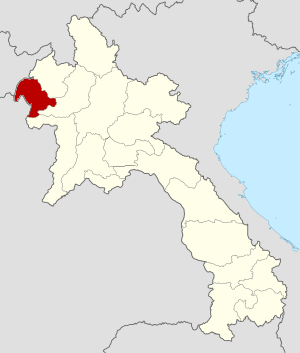
Location of Bokeo province in Laos
|
|
| Country | Laos |
| Capital | Ban Houayxay |
| Area | |
| • Total | 6,196 km2 (2,392 sq mi) |
| Population
(2020 census)
|
|
| • Total | 203,468 |
| • Density | 32.8386/km2 (85.052/sq mi) |
| Time zone | UTC+7 (ICT) |
| ISO 3166 code | LA-BK |
| HDI (2017) | 0.557 medium · 13th |
Bokeo (meaning 'gem mine') is a province in the northern part of Laos. It is the smallest province in the country by land area. It is also the second least populated province. Bokeo province covers an area of about 6,196 square kilometers.
Bokeo province shares borders with other provinces in Laos. These include Luang Namtha province to the northeast and Oudomxai province to the east. It also borders Xaignabouli province to the south. The province also shares borders with other countries. These are Thailand to the southwest and Burma (also known as Myanmar) to the west and northwest.
The province has five main areas called districts. These are Houay Xay, Tonpheung, Meung, Phaodom, and Paktha. It is famous for having many valuable and semi-precious stones. The capital city of Bokeo province is Houayxay. This city is located right on the Mekong River. Bokeo is part of the Golden Triangle area. This is where the borders of Laos, Myanmar, and Thailand meet. There are 34 different ethnic groups living in the province. Houayxay is an important border town and a center for trade.
Contents
History of Bokeo Province
Bokeo got its name because of the beautiful sapphires found there. These gems were mined in the Houayxay District. An old stone carving from 1458 can be seen at Wat Jom Kao Manilat. This temple was built in 1880 using teak wood. It shows the Shan style of building. Fort Carnot was a fort from the time when France ruled the area. It now belongs to the Lao Army.
How Bokeo Province Was Formed
Bokeo province was created in 1983. It was separated from Luang Namtha province. Later, in 1992, two districts, Paktha and Pha Oudom District, were added to Bokeo. These districts used to be part of Oudomxay province. In the past, Houayxay town was a busy trading spot. It was a place where goods from Yunnan province in China and Thailand were exchanged.
Geography of Bokeo Province
Bokeo province is the smallest province in Laos. It covers an area of 6,196 square kilometers. It shares borders with Luang Namtha province to the northeast. It also borders Oudomxay province to the east and Sainyabuli province to the south. To the southwest, it borders Thailand. To the west and northwest, it borders Burma.
Important Places and Rivers
Some important towns and villages in Bokeo include Houayxay, Mong Lin, and Ban Thakate. The Nam Nga River flows through the province. It is part of the Bokeo Nature Reserve. The province is located between the Mekong River, which borders Thailand and Burma. It is also on a trade route that connects to China. Don Sao is an island in Tonpheung District. It is connected to the mainland for most of the year.
Protected Areas and Wildlife
The Bokeo Nature Reserve was created to protect animals. It is especially important for the black crested gibbon. This type of gibbon was thought to be extinct but was found here in 1997. Other animals like elephants and wild water buffalo travel through the reserve. Bears and tigers also live there.
The Bokeo Nature Reserve
This protected area has a mix of different types of trees. It also has mountains, with heights from 500 to 1500 meters. The reserve covers a very large area. About 66,000 hectares are in Bokeo province. Another 70,000 hectares are in Luang Namtha province. The main goal is to protect the critically endangered western black crested gibbon. Surveys show there are many gibbons, especially near the Nam Kan River.
A project called the Gibbon Experience helps with conservation. It started after the black-cheeked gibbon was found. This project has two parts. One part involves special huts in the forest. These "canopy huts" are very large. They are used for watching the black-cheeked gibbons. The second part lets people experience the rainforest from high up in the trees. The Waterfall Gibbon Experience involves a three-hour hike. It takes you deep into the reserve along the Nam Nga River.
Animals in the Reserve
Besides gibbons, many other animals live in the reserve. These include the great barbet and the grey-headed parakeet. You can also find grey leaf monkeys and crab-eating mongoose. Larger animals like tigers, smaller cats, and dholes are present. There are two types of bears and also otters. Other animals include sambar and wild cattle called gaur.
Important Bird Area
The Upper Lao Mekong Important Bird Area (IBA) is also in Bokeo. It stretches across Bokeo, Oudomxay, and Sainyabuli provinces. This area is between 300 and 400 meters high. It has river channels, sandbars, islands, and rocky areas. Many different birds live here. Some examples are the black-bellied tern and the great cormorant. Other birds include the grey-headed lapwing and the swan goose.
Administrative Divisions
Bokeo province is divided into five districts. Each district has its own local government.
| Map | Code | Name | Lao script | Population (2015) |
|---|---|---|---|---|
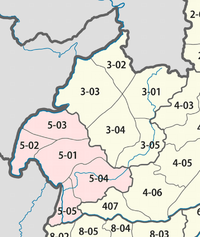 |
||||
| 5-01 | Houayxay | ເມືອງຫ້ວຍຊາຍ | 70,170 | |
| 5–02 | Ton Pheung | ເມືອງຕົ້ນເຜິ້ງ | 34,476 | |
| 5–03 | Meung | ເມືອງເມິງ | 14,506 | |
| 5–04 | Pha Oudom | ເມືອງຜາອຸດົມ | 40,909 | |
| 5–05 | Pak Tha | ເມືອງປາກທາ | 19,182 |
People of Bokeo Province
In 2015, the population of Bokeo was 179,243 people. They lived in 36 townships and over 400 villages. Bokeo province has a very diverse population. There are 34 different ethnic groups living there. This makes it the second most diverse province in Laos. Only Luang Namtha province has more different groups.
Some of the many ethnic groups include Akha, Hmong, Khamu, and Lanten. Other groups are Lahu, Yao, and Tai Lue. The Lahu people speak a language from the Tibeto-Burman family. They also live in northern Myanmar and Thailand.
Economy of Bokeo Province
The economy of Bokeo province is now largely shaped by the Golden Triangle Special Economic Zone (GT SEZ). This special zone was started in 2007. A company called Kings Romans Group leased a large area of land. This land is about 10,000 hectares along the Mekong River. Part of this area, 3,000 hectares, was made a duty-free zone. This means goods can be traded there without certain taxes.
Houayxay, the capital city, is also a major center for economic activity. Bokeo province is one of the main areas in Laos where maize (corn) is grown. Mining for precious stones and gold is also a very important part of the economy.
Mining and Crafts
Ban Nam Khok and Ban Houi Sala are important mining areas. They are located a few kilometers from Bokeo town. Buhae Industrial Corp. is a big company that mines for sapphires in Houayxay District. Many villages of the Lantaen ethnic group are known for their traditional crafts. They make paper from the saa tree and other handmade items.
Fishing in the Mekong River
The Paa beuk is a type of catfish found in the Mekong River. It is the largest freshwater fish in the world. It can grow up to 3 meters long and weigh as much as 300 kilograms. This fish is an important economic resource. It sells for a high price in the market. The meat of this endangered fish is considered a special food.
Landmarks to See
There are several beautiful temples in Houayxay, the capital city. Wat Jom Khao Manilat was built in 1880. Wat Thadsuvanna Pkakham has eight golden Buddha statues. Wat Khonekeo Xaiyaram has doors and pillars in red, gold, and green. Wat Keophone Savanthanaram has a reclining Buddha statue. The old French Fort Carnot used to be here, but its buildings are now gone.
Gallery
See also
 In Spanish: Provincia de Bokeo para niños
In Spanish: Provincia de Bokeo para niños


